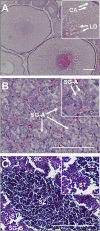Phospholipid and LC-PUFA metabolism in Atlantic salmon (Salmo salar) testes during sexual maturation
- PMID: 32469895
- PMCID: PMC7259613
- DOI: 10.1371/journal.pone.0233322
Phospholipid and LC-PUFA metabolism in Atlantic salmon (Salmo salar) testes during sexual maturation
Abstract
The importance of dietary lipids in male reproduction are not as well understood as in females, in which dietary lipids, such as phospholipids (PL) and associated fatty acids (FA), are important structural components of the eggs and provide energy for their offspring. In mammals, lipids are suggested to be important for spermatogenesis and to structural components of the spermatozoa that could improve fertilization rates. New knowledge of how lipids affect sexual maturation in male Atlantic salmon (Salmo salar), an important global aquaculture species, could provide tools to delay maturation and/or improve reproductive success. Therefore, changes in testicular composition of lipids and gene transcripts associated with spermatogenesis and lipid metabolism were studied in sexually maturing male salmon compared to immature males and females. An increase in total testis content of FA and PL, and a shift to higher PL composition was observed in maturing males, concomitant with increases in mRNA levels for genes involved in spermatogenesis, FA uptake and synthesis, and production of long chain-polyunsaturated fatty acids (LC-PUFA) and PL. A particularly interesting finding was elevated testis expression of acyl-CoA synthetase 4 (acsl4), and acyl-CoA thioesterase 2 (acot2), critical enzymes that regulate intra-mitochondrial levels of 20:4n-6 FA (arachidonic acid), which have been associated with improved cholesterol transport during steroidogenesis. This suggested that FA may have direct effects on sex steroid production in salmon. Furthermore, we observed increased testis expression of genes for endogenous synthesis of 16:0 and elongation/desaturation to 22:6n-3 (docosahexaenoic acid) in sexually maturing males relative to immature fish. Both of these FA are important structural components of the PL, phosphatidylcholine (PC), and were elevated concomitant with increases in the content of phosphatidic acid, an important precursor for PC, in maturing males compared to immature fish. Overall, this study suggests that, similar to mammals, lipids are important to spermatogenesis and serve as structural components during testicular growth and maturation in Atlantic salmon.
Conflict of interest statement
This study was funded by Nofima As and supported by the NOAA NWFSC. The Funder of this study, Nofima, did not play a role in the study design, data collection and analysis, decision to publish, or preparation of the manuscript and only provided financial support in the form of authors' [ASB, MTB, JED and KAR] salaries and research materials. The authors declare that one author [ESH] has a commercial affiliation with Ocean Associates Inc. The commercial affiliation of one author [ESH] does not alter our adherence to PLoS ONE policies on sharing data and materials.
Figures








Similar articles
-
Molecular Regulation of Biosynthesis of Long Chain Polyunsaturated Fatty Acids in Atlantic Salmon.Mar Biotechnol (NY). 2022 Aug;24(4):661-670. doi: 10.1007/s10126-022-10144-w. Epub 2022 Jul 30. Mar Biotechnol (NY). 2022. PMID: 35907166 Free PMC article. Review.
-
Influence of dietary docosahexaenoic acid in combination with other long-chain polyunsaturated fatty acids on expression of biosynthesis genes and phospholipid fatty acid compositions in tissues of post-smolt Atlantic salmon (Salmo salar).Comp Biochem Physiol B Biochem Mol Biol. 2014 Jun-Jul;172-173:74-89. doi: 10.1016/j.cbpb.2014.04.007. Epub 2014 May 5. Comp Biochem Physiol B Biochem Mol Biol. 2014. PMID: 24807616
-
CRISPR/Cas9-mediated editing of Δ5 and Δ6 desaturases impairs Δ8-desaturation and docosahexaenoic acid synthesis in Atlantic salmon (Salmo salar L.).Sci Rep. 2019 Nov 15;9(1):16888. doi: 10.1038/s41598-019-53316-w. Sci Rep. 2019. PMID: 31729437 Free PMC article.
-
The initiation of puberty in Atlantic salmon brings about large changes in testicular gene expression that are modulated by the energy status.BMC Genomics. 2019 Jun 11;20(1):475. doi: 10.1186/s12864-019-5869-9. BMC Genomics. 2019. PMID: 31185904 Free PMC article.
-
Leptin in fish: possible role in sexual maturation in male Atlantic salmon.Fish Physiol Biochem. 2013 Feb;39(1):103-6. doi: 10.1007/s10695-012-9731-0. Epub 2012 Oct 7. Fish Physiol Biochem. 2013. PMID: 23053613 Review.
Cited by
-
Molecular Regulation of Biosynthesis of Long Chain Polyunsaturated Fatty Acids in Atlantic Salmon.Mar Biotechnol (NY). 2022 Aug;24(4):661-670. doi: 10.1007/s10126-022-10144-w. Epub 2022 Jul 30. Mar Biotechnol (NY). 2022. PMID: 35907166 Free PMC article. Review.
-
Expression of genes and localization of enzymes involved in polyunsaturated fatty acid synthesis in rabbit testis and epididymis.Sci Rep. 2022 Feb 16;12(1):2637. doi: 10.1038/s41598-022-06700-y. Sci Rep. 2022. PMID: 35173269 Free PMC article.
-
UPLC-QTOF/MS Metabolomics and Biochemical Assays Reveal Changes in Hepatic Nutrition and Energy Metabolism during Sexual Maturation in Female Rainbow Trout (Oncorhynchus mykiss).Biology (Basel). 2022 Nov 18;11(11):1679. doi: 10.3390/biology11111679. Biology (Basel). 2022. PMID: 36421392 Free PMC article.
-
Drosophila Lysophospholipase Gene swiss cheese Is Required for Survival and Reproduction.Insects. 2021 Dec 22;13(1):14. doi: 10.3390/insects13010014. Insects. 2021. PMID: 35055857 Free PMC article.
References
-
- Aksnes A, Gjerde B, Roald SO. Biological, chemical and organoleptic changes during maturation of farmed Atlantic salmon, Salmo salar. Aquaculture. 1986;53:7–20.
-
- Kusakabe M, Nakamura I, Evans J, Swanson P, Young G. Changes in mRNAs encoding steroidogenic acute regulatory protein, steroidogenic enzymes and receptors for gonadotropins during spermatogenesis in rainbow trout testes. J Endocrinol. 2006;189(3):541–54. - PubMed
-
- Tyler CR, Sumpter JP. Oocyte growth and development in teleosts. Reviews in Fish Biology and Fisheries.19966; 287–318.
-
- Izquierdo MS, Fernández-Palacios H, Tacon AGJ. Effect of broodstock nutrition on reproductive performance of fish. Aquaculture. 2001;197:25–42.
-
- Brooks S, Tyler CR, Sumpter JP. Egg quality in fish: what makes a good egg? Rev Fish Biol Fisher. 1997;7(4):387–416.
Publication types
MeSH terms
Substances
LinkOut - more resources
Full Text Sources

